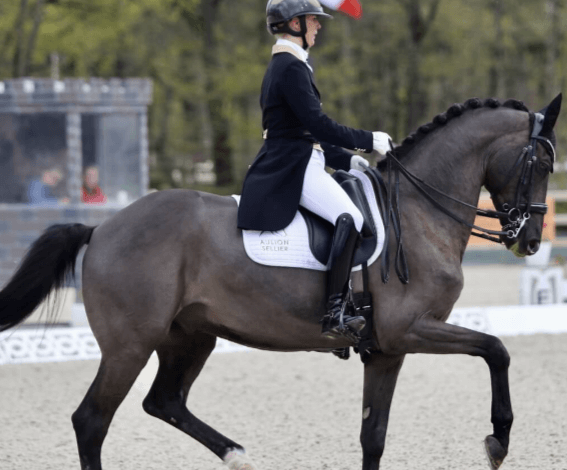How can riders develop the precision and grace required for dressage?

Introduction
Dressage, often referred to as “horse ballet,” is a highly skilled form of riding that requires both horse and rider to perform a series of predetermined movements, known as “tests,” with precision and grace. This sport, rooted in centuries of equestrian tradition, demands a deep bond between horse and rider, as well as rigorous training and discipline. In this article, we will explore how riders can develop the precision and grace required for dressage, focusing on essential techniques, training methods, and expert advice to help you and your horse perform at your best.
Understanding Dressage
What is Dressage?
Dressage is a form of equestrian sport where horse and rider are expected to perform a series of predetermined movements, or tests, from memory. These tests are designed to showcase the horse’s training, responsiveness, and the rider’s control. Dressage movements can range from basic walk, trot, and canter transitions to more advanced maneuvers such as pirouettes, piaffes, and passage.
History of Dressage
Dressage has a rich history dating back to ancient Greece, where it was practiced as a method of training cavalry horses for war. The techniques were later refined and formalized in the Renaissance period, particularly in the courts of European nobility. Today, dressage is a prominent competitive sport, governed by organizations such as the Fédération Équestre Internationale (FEI).
Importance of Precision and Grace
The essence of dressage lies in the harmony and partnership between horse and rider. Precision in executing movements and grace in transitions are crucial for achieving high scores in dressage tests. This requires meticulous training, a deep understanding of horse behavior, and a commitment to continuous improvement.
Fundamental Principles of Dressage
The Training Scale
The training scale is a foundational concept in dressage, comprising six key elements: rhythm, suppleness, contact, impulsion, straightness, and collection. These principles guide the training process, ensuring that the horse develops the necessary balance, flexibility, and strength.
Rhythm and Tempo
Rhythm refers to the regularity of the horse’s gait, while tempo is the speed of the rhythm. Both are crucial for creating a fluid and balanced performance. Consistent rhythm and appropriate tempo help the horse maintain balance and execute movements with precision.
Suppleness and Flexibility
Suppleness refers to the horse’s ability to bend and flex its body, while flexibility involves the range of motion in its joints. Developing suppleness and flexibility is essential for performing lateral movements and achieving collection.
Building a Strong Foundation
Basics of Rider Position
A correct rider position is fundamental to effective communication with the horse. This includes a balanced seat, relaxed legs, and soft hands. A well-aligned rider can give clear and consistent aids, leading to better performance.
Effective Communication with Your Horse
Effective communication involves using subtle aids—such as leg, seat, and rein aids—to guide the horse’s movements. It is essential for riders to be consistent and clear with their signals to avoid confusion and ensure precision.
Importance of Groundwork
Groundwork exercises, such as lunging and long-lining, help establish respect and responsiveness in the horse. These exercises build the foundation for more advanced ridden work and improve the horse’s overall suppleness and obedience.
Developing Precision
Mastering the Aids
Mastering the aids involves learning how to use leg, seat, and rein aids effectively to communicate with the horse. Precision in the use of aids ensures that the horse understands and responds correctly to the rider’s signals.
Importance of Consistency
Consistency in training and riding helps the horse understand what is expected. Regular practice of movements and exercises builds muscle memory in the horse, leading to more accurate and precise performances.
Using Markers and Patterns
Using markers (such as letters in the arena) and riding specific patterns helps riders develop spatial awareness and precision. This practice also helps horses learn to anticipate and execute movements accurately.
Enhancing Grace
Importance of Balance
Balance is key to achieving graceful movements in dressage. Both horse and rider must be balanced to execute transitions and movements smoothly. Balance helps prevent stiffness and promotes fluidity in performance.
Developing Fluid Movements
Fluid movements are achieved through relaxation and proper training. Riders should focus on maintaining a steady contact and encouraging the horse to move forward freely and confidently.
Harmony between Horse and Rider
Harmony between horse and rider is the hallmark of dressage. This involves mutual trust, clear communication, and a deep bond. Achieving harmony requires patience, practice, and a willingness to understand and work with the horse’s natural abilities.
Advanced Dressage Techniques
Collection and Extension
Collection involves shortening the horse’s stride while maintaining energy and impulsion. Extension, on the other hand, requires lengthening the stride. Both techniques are advanced skills that demonstrate the horse’s strength, balance, and responsiveness.
Lateral Movements
Lateral movements, such as shoulder-in, travers, and half-pass, involve the horse moving sideways while maintaining forward motion. These movements improve suppleness, balance, and coordination.
Flying Changes
Flying changes are changes of lead at the canter without breaking into a trot. They are a demonstration of the horse’s agility and the rider’s ability to give precise aids. This advanced movement is often seen in higher-level dressage tests.
Training and Conditioning
Importance of a Training Plan
A structured training plan helps riders and horses progress systematically. It ensures that all aspects of dressage training—such as basic movements, advanced techniques, and conditioning—are addressed.
Fitness for Horse and Rider
Fitness is crucial for both horse and rider in dressage. Horses need strength, stamina, and flexibility, while riders require core strength, balance, and flexibility to give effective aids and maintain a correct position.
Avoiding Overtraining
Overtraining can lead to fatigue, soreness, and a decline in performance. It is important to balance work with adequate rest and recovery periods to ensure the horse remains healthy and motivated.
Mental Preparation and Focus
Developing Rider Confidence
Confidence is key to successful dressage performance. Riders can build confidence through regular practice, positive reinforcement, and setting achievable goals.
Visualization Techniques
Visualization involves mentally rehearsing movements and tests. This technique helps riders prepare for competition and improve their performance by reinforcing muscle memory and boosting confidence.
Managing Competition Stress
Competition stress is common in dressage. Riders can manage stress by developing a pre-competition routine, practicing relaxation techniques, and focusing on the positive aspects of their performance.
Common Dressage Challenges and Solutions
Addressing Resistance
Resistance in dressage can manifest as stiffness, refusal to move forward, or reluctance to perform movements. Addressing resistance involves understanding the root cause and using gentle, consistent training methods to overcome it.
Improving Accuracy
Accuracy in dressage is achieved through consistent practice and attention to detail. Riders should focus on riding precise figures and transitions, using arena markers to guide their movements.
Handling Nervous Horses
Nervous horses can be calmed through gentle handling, consistent routines, and gradual exposure to new environments. Building trust and confidence in the horse is essential for overcoming nervousness.
Expert Tips for Success
Insights from Professional Riders
Professional riders emphasize the importance of patience, consistency, and a positive attitude. They recommend regular lessons with a knowledgeable trainer and staying updated with the latest training methods and techniques.
Importance of Regular Lessons
Regular lessons with a qualified trainer provide valuable feedback and guidance. Trainers can help identify areas for improvement and offer tailored advice to enhance performance.
Staying Updated with Trends
Dressage is an evolving sport, with new techniques and trends emerging regularly. Staying informed through clinics, workshops, and reading equestrian publications helps riders keep their training methods current.
Dressage Competitions
Preparing for Your First Show
Preparing for a dressage show involves thorough practice of tests, understanding the rules and requirements, and ensuring the horse is fit and well-groomed. Riders should also familiarize themselves with the competition environment.
Understanding Dressage Levels
Dressage competitions are organized into different levels, from basic to advanced. Each level has specific requirements and movements that riders must perform. Understanding these levels helps riders set appropriate goals.
Scoring and Feedback
Dressage tests are scored based on accuracy, fluidity, and overall impression. Judges provide feedback that highlights strengths and areas for improvement, guiding riders in their future training.
Equipment and Tack
Choosing the Right Saddle
A well-fitted saddle is crucial for both horse and rider comfort. It should support the rider’s position and allow the horse to move freely without restriction.
Importance of Bit Selection
The bit is an important tool for communication in dressage. Choosing the right bit depends on the horse’s mouth conformation and training level. It should be comfortable for the horse and allow precise communication.
Grooming Tools for Dressage
Grooming tools, such as brushes, combs, and hoof picks, are essential for maintaining the horse’s coat, mane, and hooves. Regular grooming enhances the horse’s appearance and promotes health.
Dressage Horse Selection
Characteristics of a Good Dressage Horse
A good dressage horse should have a natural aptitude for the sport, including balance, flexibility, and a willingness to learn. Temperament and trainability are also important factors.
Breeds Best Suited for Dressage
Certain breeds, such as Warmbloods, are particularly well-suited for dressage due to their physical conformation and movement. However, horses of various breeds can excel in dressage with proper training.
Evaluating Potential Horses
When evaluating potential dressage horses, consider factors such as conformation, movement, temperament, and health. A thorough veterinary examination is also essential.
Role of the Trainer
Finding a Good Trainer
Finding a good trainer involves researching their experience, qualifications, and teaching style. Recommendations from other riders and observing a trainer’s lessons can also help in making a decision.
Building a Relationship with Your Trainer
A positive relationship with your trainer is essential for progress. Open communication, mutual respect, and a shared commitment to your goals help build a successful partnership.
Importance of Consistent Training
Consistent training with a knowledgeable trainer helps ensure steady progress. Regular lessons provide structure and accountability, helping riders stay on track with their training goals.
Developing a Dressage Routine
Daily Riding Schedule
A daily riding schedule helps maintain consistency and discipline. It should include time for warm-up, training, cool-down, and rest.
Importance of Rest Days
Rest days are crucial for the horse’s recovery and overall well-being. They help prevent fatigue and injury, allowing the horse to perform at its best.
Incorporating Cross-Training
Cross-training, such as trail riding, jumping, or ground work, helps keep the horse engaged and physically fit. It also prevents boredom and enhances overall performance.
Health and Nutrition
Diet for Optimal Performance
A balanced diet is essential for a dressage horse’s performance. It should include a mix of forage, grains, and supplements to meet the horse’s nutritional needs.
Supplements for Dressage Horses
Supplements, such as vitamins, minerals, and joint support, can enhance a horse’s health and performance. However, they should be used under the guidance of a veterinarian.
Recognizing Health Issues
Regular health checks and being observant of changes in the horse’s behavior, appetite, or performance can help identify health issues early. Prompt veterinary care is essential for addressing any concerns.
Rider Fitness and Health
Exercises for Rider Strength
Strength training exercises, such as core workouts, leg exercises, and upper body conditioning, help riders maintain a stable and balanced position.
Importance of Flexibility
Flexibility is crucial for riders to move fluidly with the horse. Stretching exercises and yoga can enhance flexibility and prevent stiffness.
Managing Rider Health Issues
Riders should address any health issues promptly to avoid affecting their performance. Regular check-ups, proper nutrition, and a balanced lifestyle contribute to overall well-being.
Dressage Myths and Facts
Common Misconceptions
Common misconceptions about dressage include the belief that it is only for specific breeds or that it requires expensive equipment. In reality, dressage is accessible to riders of all levels and disciplines.
Debunking Dressage Myths
Debunking myths involves educating riders about the true nature of dressage. Emphasizing the importance of training, consistency, and partnership with the horse helps dispel misconceptions.
Facts Every Rider Should Know
Every rider should know that dressage is a progressive sport that requires patience and dedication. Understanding the principles and techniques of dressage is key to achieving success.
Dressage as an Art and Sport
Balancing Artistry with Athleticism
Dressage is both an art and a sport, requiring a balance of creativity and physical prowess. Riders must develop technical skills while also expressing their individual style.
Role of Music in Dressage
Music plays a significant role in dressage, particularly in freestyle competitions. It enhances the performance, creating a harmonious and engaging experience for both horse and rider.
Inspiring Dressage Performances
Inspiring dressage performances showcase the pinnacle of horse-rider harmony and technical skill. Watching top riders can provide motivation and insight into achieving excellence in dressage.
Dressage Community and Resources
Joining Dressage Clubs
Joining dressage clubs and associations provides riders with opportunities for learning, networking, and competition. These organizations offer support and resources for dressage enthusiasts.
Online Resources for Riders
Online resources, such as forums, training videos, and articles, offer valuable information for dressage riders. Staying connected with the online community helps riders stay informed and motivated.
Networking with Other Riders
Networking with other riders provides opportunities for learning and support. Sharing experiences and advice helps build a sense of community and fosters growth in the sport.
Dressage and Other Equestrian Disciplines
Comparing Dressage with Show Jumping
Dressage and show jumping are distinct disciplines, each with its own set of skills and techniques. While dressage focuses on precision and grace, show jumping emphasizes speed and agility.
Eventing and Western Riding
Eventing combines dressage, show jumping, and cross-country, requiring versatility and stamina. Western riding, with its own set of styles and techniques, offers a different approach to horsemanship.
Future of Dressage
Trends in Dressage Training
Trends in dressage training include the use of technology, such as video analysis and biomechanics, to enhance performance. Modern training methods focus on the welfare of the horse and sustainable practices.
Technological Advances
Technological advances, such as wearable sensors and virtual reality training, offer new ways to improve riding skills and horse management. These tools provide valuable data and insights for riders and trainers.
Dressage in the Olympics
Dressage has been a part of the Olympics since 1912. Its inclusion highlights the sport’s prestige and the high level of skill required. The future of dressage in the Olympics looks promising, with continued growth and development in the sport.
FAQs
How can riders develop the precision and grace required for dressage? Riders can develop precision and grace through consistent practice, understanding the training scale, and working closely with a knowledgeable trainer. Regular lessons, clear communication with the horse, and focusing on balance and suppleness are key factors. Additionally, riders should incorporate visualization techniques and maintain their own fitness and flexibility.
What is the training scale in dressage? The training scale is a foundational framework in dressage that includes six elements: rhythm, suppleness, contact, impulsion, straightness, and collection. These principles guide the systematic development of the horse’s training and ensure a balanced and harmonious performance.
How important is rider position in dressage? Rider position is crucial in dressage as it affects communication with the horse and overall performance. A correct position ensures effective use of aids and helps maintain balance and harmony between horse and rider.
What are some common challenges in dressage and how can they be addressed? Common challenges in dressage include resistance, lack of accuracy, and handling nervous horses. These can be addressed through consistent training, understanding the horse’s behavior, and using gentle, positive reinforcement techniques.
How can riders prepare for their first dressage competition? Preparing for a first dressage competition involves thorough practice of tests, understanding competition rules, and ensuring both horse and rider are in peak condition. Riders should also familiarize themselves with the competition environment and develop a pre-competition routine to manage stress.
What role does fitness play in dressage? Fitness is essential for both horse and rider in dressage. Horses need strength, stamina, and flexibility to perform movements accurately, while riders require core strength, balance, and flexibility to give effective aids and maintain a correct position. Regular exercise and conditioning are crucial for optimal performance.
Conclusion
Developing the precision and grace required for dressage is a journey that demands dedication, patience, and a deep understanding of the horse-rider partnership. By mastering the fundamentals, building a strong foundation, and continuously striving for improvement, riders can achieve excellence in this elegant and challenging sport. Embrace the principles of dressage, stay committed to your training, and enjoy the harmonious connection with your horse that makes dressage truly special.





